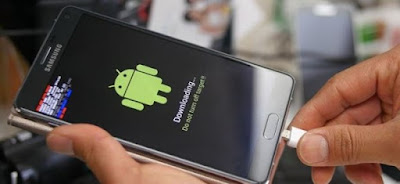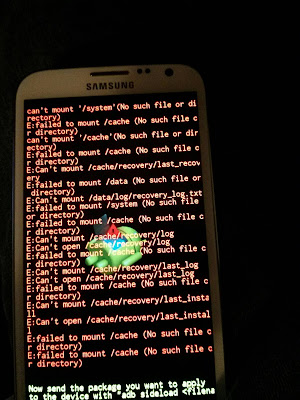 |
| Flashing illustration |
Anda berbicara Bahasa Indonesia? Baca artikel terjemahannya di sini!
Android users have been treated with one strong benefit: choice. Imagine, you have lots of devices to choose, all with various specs and manufacturers. If you want, you can also change the phone’s stock OS to community-made ones (dubbed flashing). I’ve never seen any mobile OS did this before. To be fair, iOS users also have access to jailbreaking, but it’s becoming less and less popular now, since it relies on the OS’ security flaws, which Apple patches regularly.
Believe it or not, I also used to enjoy flashing, but that was years ago. Android devices weren’t as affordable as they are now, and the fragmentation was so bad that devices felt old very fast.
My first Android device was the original Samsung Galaxy S. It was a big, reliable device that was dubbed “The iPhone Killer”. I’ve kept it for almost 4-5 years, I think, even though it stays in the drawer after the second year. I decided to give it a new lease of life with custom ROM, and it went on and on until the device felt really sluggish, battery was dead, and replacements were difficult. It was the time for me to let it go.
 |
| The original Samsung Galaxy S. Prelude to one of the most prominent Android flagships. |
But that was the past. Now, as I grow older and older, I’ve gone tired with it. I’m still doing some flashing, but not for fun.
Here are a few reasons why I quit flashing. Oh, before you bash me, please note that this is merely my opinion intended for general users. Of course, you may disagree, and we can discuss it further in the comments section below.
Smartphones Have become Better and More Affordable
 |
| Xiaomi’s Redmi line is synonymous with the phrase “Value for Money” |
Compared to a decade ago, smartphones have become much better, in terms of both hardware and software, and affordable. Heck, even low-end phones and mid-rangers are already fast enough for most tasks these days.
Phone prices have also gone lower thanks to the siege from Chinese manufacturers like Xiaomi, Huawei, Oppo, and Vivo. During early days of Android, lower prices mean sluggish performance. Now that’s no longer the case.
I have seen many people using their mid-range devices for at least 2 years, and when I asked why they kept their phone for that long, they simply replied, “It’s enough for my needs.”. When I asked when they would buy a new phone, they replied, “Until my phone broke down.”
Mid-Range Phones Picks Up The Pace
Nowadays people look up to flagships because of their shiny new features. Fast forward a year, and you’ll probably find those features in mid-range phones. Multi-camera setups are the example of this. There are different implementations, yes, but it was initially only available on flagships.
 |
| Samsung’s Galaxy A7 and A9 are the first mid-range phones to feature more than two cameras. |
Some features may remain exclusive for flagships, such as Dual OIS or high resolution OLED screen, but hey, let me ask you a question: How much do you need them?
Flashing Requires Thoroughness
XDA has long time been the go-to source for flashing firmwares. If you’ve ever been to one of their custom firmware threads, I’m sure you’re familiar with the long list of pre-requisites, disclaimers, and known issues.
You need to make sure that you’ve read every single line of those texts before you flash, or you’ll be facing trouble, which brings us to the next point…
Flashing Has Consequences
Anyone who has flashed before should know that they put their device at risk. I’m not talking about warranty, but rather the risk that you may brick your device. There are two types of brick: soft brick and hard brick. If you got the former, you can try reflashing and see if you’re in luck. However, if you got the latter, you’re pretty much screwed.
 |
| Bricking your device is one of the biggest risks in flashing. |
Some ROMs also offer root out of the box. Though this may be good news for those the tinkerers, you may lose access to your financial and banking apps, as they don’t allow root access for security reasons.
If you flash on a second device, good for you. As for me who prefers to use only a single device, I’d rather lose root access than my finance apps.
Be Wise on Choosing Which ROM to Install
Sure, custom ROMs may offer better performance tweaks, newer Android versions, and shiny new features. However, you also need to choose your provider wisely.
 |
| Lineage OS is one of the better custom ROM choices for the masses out there. |
The beauty of Android’s open source model is that everyone is allowed to create their own ROMs. However, again, no ROM is perfect. So, if you choose to go this path, make sure you choose a credible provider. Why, because there will be bugs, and not all developers out there are motivated enough to maintain their ROM for a long while.
Conclusion: Know The Consequences
This isn’t a hate post for those who love to flash their phones, but rather a disclaimer for those haven’t flashed… or at least thinking about flashing.
Again, I’m not saying that flashing is bad. In some cases, it’s even necessary. For example, to replace fake ROMs in certain Xiaomi devices. However, it’s also important to know about its consequences.
Well, I guess that’s all for now, Folks. This is an opinion piece, so feel free to leave your agreement/disagreement/comments in the comment section below. Finally, as usual, thanks for reading and see you in the next article! 😀
